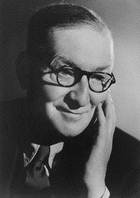

Sir John Cockcroft was a member of the NIRNS Atlas Computer Committee from 1961 to 1964.
He was born at Todmorden on May 27th, 1897. His family had for several generations been cotton manufacturers. He was educated at Todmorden Secondary School and studied mathematics at Manchester University from 1914-1915. After serving in the First World War in the Royal Field Artillery he returned to Manchester to study electrical engineering at the College of Technology. After two years apprenticeship with Metropolitan Vickers Electrical Company he went to St. John's College, Cambridge, and took the Mathematical Tripos in 1924. At Cambridge he became a Fellow in 1929 and a Professor of Natural Philosophy in 1939. Much of his earlier work was in the field of Engineering but he later turned to Physics.


Shortly before the Second World War began, he realized the great importance of Radar for air craft detection in the defence of Britain, and both at the Cavendish Laboratory and Malvern he was involved in the development of Radar.
In 1944 he went to Canada as Director of the Atomic Energy Division, National Research Council of Canada at the University of Montreal. In about a year the first zero energy heavy water reactor, ZEEP, was built. British members of the team also began to work on the design of the first atomic pile to be constructed in Britain, at the Atomic Energy Research Establishment, and former Royal Air Force Establishment, at Harwell.
This was a graphite moderated reactor (because heavy water was not available). They also began work at Chalk River on the chemical process to be used for the separation of plutonium and fission products from irradiated uranium. This process was used in the chemical separation plant at Windscale.
The Atomic Energy Research Establishment at Harwell was founded on January 1st, 1946. Sir John visited the newly acquired Harwell airfield on a wet windy day in February 1946. The R.A.F. barrack blocks were converted into laboratories and offices and 100 prefabs were erected to house staff and by August of 1947 the first Atomic Pile, GLEEP, was operating. About a year later a second pile BEPO was operating.
The Harwell Prefabs lasted 50 years and many Atlas staff had a Harwell Prefab as their first home.
The 1950s at Harwell were mainly spent in the design and construction of nuclear power plants. By the end of 1952 it had been shown that a nuclear power station could be built to develop 50,000 KW of electricity and that it could produce substantial quantities of plutonium as a by-product.
Harwell also built a set of aluminium donuts of increasing size wrapped round with coils to produce a strong magnetic field. This process culminated in ZETA with a diameter of one metre. Heating up the gas by passing currents of up to 900,000 amps through it, it was possible to increase the temperature of the gas from 500,000 degrees to 5 million degrees. Simulations on the Harwell Mercury suggested that thermonuclear fusion was possible and a new Laboratory was created at Culham with the intention, initially, to build a machine called ICSE.
For the period 1954-1959 he was scientific research member of the U.K. Atomic Energy Authority. He became Master, Churchill College, Cambridge in October 1959. He died in 1967.